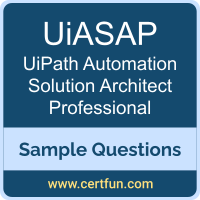 The purpose of this Sample Question Set is to provide you with information about the UiPath Automation Solution Architect Professional (UiASAP) exam. These sample questions will make you very familiar with both the type and the difficulty level of the questions on the UiASAP certification test. To get familiar with real exam environment, we suggest you try our Sample UiPath UiASAP Certification Practice Exam. This sample practice exam gives you the feeling of reality and is a clue to the questions asked in the actual UiPath Certified Professional Automation Solution Architect Professional (UiASAP) certification exam.
The purpose of this Sample Question Set is to provide you with information about the UiPath Automation Solution Architect Professional (UiASAP) exam. These sample questions will make you very familiar with both the type and the difficulty level of the questions on the UiASAP certification test. To get familiar with real exam environment, we suggest you try our Sample UiPath UiASAP Certification Practice Exam. This sample practice exam gives you the feeling of reality and is a clue to the questions asked in the actual UiPath Certified Professional Automation Solution Architect Professional (UiASAP) certification exam.
These sample questions are simple and basic questions that represent likeness to the real UiPath Automation Solution Architect Professional exam questions. To assess your readiness and performance with real-time scenario based questions, we suggest you prepare with our Premium UiPath UiASAP Certification Practice Exam. When you solve real time scenario based questions practically, you come across many difficulties that give you an opportunity to improve.
UiPath UiASAP Sample Questions:
01. From a deployment standpoint, which item is related to the Orchestrator Deployment?
a) Ease of upscaling during peak loads and off-peak downscaling
b) Workstation Environment or Windows Server Environment.
c) Operating Infra Environment - VDI or VM
d) Disaster Recovery and Automatic Failover strategies.
02. How do apps built with UiPath Apps interact with back-end systems when running automation locally?
a) By triggering an Attended Robot to interact with back-end systems.
b) By relying on third-party middleware to bridge the communication.
c) Apps built with UiPath Apps cannot interact with the back-end system.
d) By using APIs provided by the back-end system.
03. Why is stakeholder input important during the process analysis phase?
a) It is only important for financial stakeholders.
b) Stakeholder input is generally not important in process analysis.
c) To ensure the analysis aligns with business objectives and captures all aspects of the process.
d) It's primarily for gathering social media insights.
04. In an Attended Automation scenario, where are the robots typically deployed?
a) On a central server managed by IT.
b) On user’s local machines.
c) Exclusively in the cloud.
d) On dedicated external devices.
05. How can the scalability of an RPA solution be enhanced?
a) Designing the architecture to balance the load using queueing and distribution amongst multiple automation robots.
b) Running automation exclusively on a single bot to maintain control.
c) Designing the process in such a way that error reporting is properly managed.
d) Avoiding the separation of functionality and include all activities in a single workflow.
06. What deployment models are supported by UiPath?
a) Only Cloud deployment.
b) Only On-premises deployment.
c) Both Cloud and On-premises deployments.
d) Neither Cloud nor On-premises deployments.
07. Where can UiPath Communications Mining be deployed?
a) In UiPath Automation Cloud.
b) In both UiPath Automation Cloud and UiPath Automation Suite.
c) In UiPath Automation Suite.
d) As a standalone product.
08. What feature does UiPath Automation Ops provide for collaboration among development teams?
a) A gaming platform for team building.
b) Facilities for shared access and version control of automation projects.
c) Only email communication tools.
d) There are no collaboration features in Automation Ops.
09. Which type of AI models can be managed in UiPath AI Center?
a) Only third-party pre-trained models.
b) Only UiPath developed models.
c) Both UiPath and custom third-party models.
d) AI Center does not support AI models.
10. When structuring data using Entities in UiPath Data Service for RPA projects, which approach is crucial for promoting data organization and management efficiency?
a) Adopting a single, all-encompassing Entity to cover all instances and avoid redundancies.
b) Modeling custom Entities based on business objects, while incorporating rich metadata, relationships, and attributes as needed.
c) Prioritizing standard, built-in fields and Entities over tailored solutions specific to project requirements.
d) Ignoring metadata and relationships between Entities in favor of simplified data structures.
Answers:
|
Question: 01 Answer: d |
Question: 02 Answer: a |
Question: 03 Answer: c |
Question: 04 Answer: b |
Question: 05 Answer: a |
|
Question: 06 Answer: c |
Question: 07 Answer: d |
Question: 08 Answer: b |
Question: 09 Answer: c |
Question: 10 Answer: b |
Note: For any error in UiPath Certified Professional Automation Solution Architect Professional (UiASAP) certification exam sample questions, please update us by writing an email on feedback@certfun.com.
